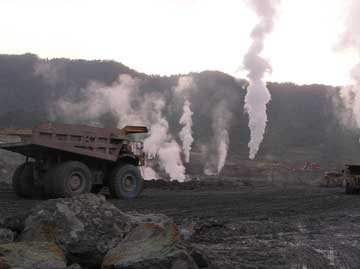|
News Notes
Mining
Gold mine deposited rapidly
 For those with gold fever, there’s good news. One of the world’s largest gold deposits may have been deposited in the geologic blink of an eye — within only 55,000 years.
For those with gold fever, there’s good news. One of the world’s largest gold deposits may have been deposited in the geologic blink of an eye — within only 55,000 years.
Steam rises from the active hydrothermal system at Ladolam gold mine on Lihir Island in Papua New Guinea. Ladolam’s giant gold deposit could have formed in as little as 55,000 years. Photograph is by K. Brown and S. Simmons.
Lihir Island in Papua New Guinea is home to the Ladolam gold deposit, which contains about 1,600 metric tons of gold. The only known active deposit of its kind, it lies at the center of the island in the remnants of an ancient collapsed volcano, and is part of an extensive hydrothermal system of superheated, mineral-rich fluids.
The fluids at Ladolam contain dissolved gold, which stays in solution at the high pressures deep within the extinct volcano, but precipitates out as the fluids rise toward the surface and decompress. Geologists are still uncertain about the origin of those fluids, how much fluid is needed, and how long it takes for the fluids to build a major ore deposit, says Christoph Heinrich, an economic geologist at the University of Zurich in Switzerland. Understanding these factors is important for locating and developing such deposits, Heinrich says.
Indeed, hydrothermal ore deposits make up about 50 percent of the world’s mined gold, says Stuart Simmons, a geologist at the University of Auckland in New Zealand. “Although luck has a large part to do with the discovery of new deposits, it always seems to help to know as much as possible about the processes that caused the deposits to form,” he says.
To better understand the Ladolam deposit, Simmons and Kevin Brown, a geologist at GEOKEM, a New Zealand-based geochemical company, studied the chemistry of the deep magmatic fluids in wells drilled more than 1 kilometer below the land surface. The water contained about 15 parts per billion gold, which is a relatively “modest” concentration compared to some magmatic fluids, Simmons says. Even so, at the current rate of water flow, the Ladolam deposit could have formed within just 55,000 years — compared with an estimated 5 million years for another giant deposit in Yanacocha, Peru, the authors reported in the Oct. 13 Science.
What makes the rapid formation at Ladolam possible is that the fluids are able to both transport and deposit the gold efficiently and steadily, pumping it to the surface and dropping it at depths of between 100 and 500 meters below the surface, Simmons says. “Our results show that ore formation depends greatly on an efficient mechanism of precipitation,” he says, which is “an important message applicable to all hydrothermal deposits.”
Simmons and Brown’s find may help in the search for other, older ore deposits, says Heinrich, who wrote a perspectives piece in the same issue of Science about the find. “Knowing how they form and how the architecture of the ore-forming system worked at the time” can help scientists locate relatively small ore deposits within a large region of hydrothermally altered rocks, he says.
The new discovery also indicates an unusually low concentration of sulfides in the magmatic fluids, suggesting that the deposit may have formed even more suddenly, Heinrich says. Because more sulfides in the fluids can help keep higher concentrations of gold dissolved, the unusually low concentrations of both gold and sulfides suggest that an abrupt event may have occurred that suddenly removed those compounds from the fluids. Thus, the current fluids may be only a shadow of the chemical-rich solutions that used to circulate under the volcano.
A possible sudden event that could account for such a change is the collapse of the volcanic dome. Such a collapse may have caused the highly concentrated fluids to rapidly rise and expand, depositing their load of dissolved gold all at once. That could mean that the deposit formed on an even shorter timescale — perhaps even within a human lifespan, Heinrich says.
Carolyn Gramling

 Subscribe
Subscribe

